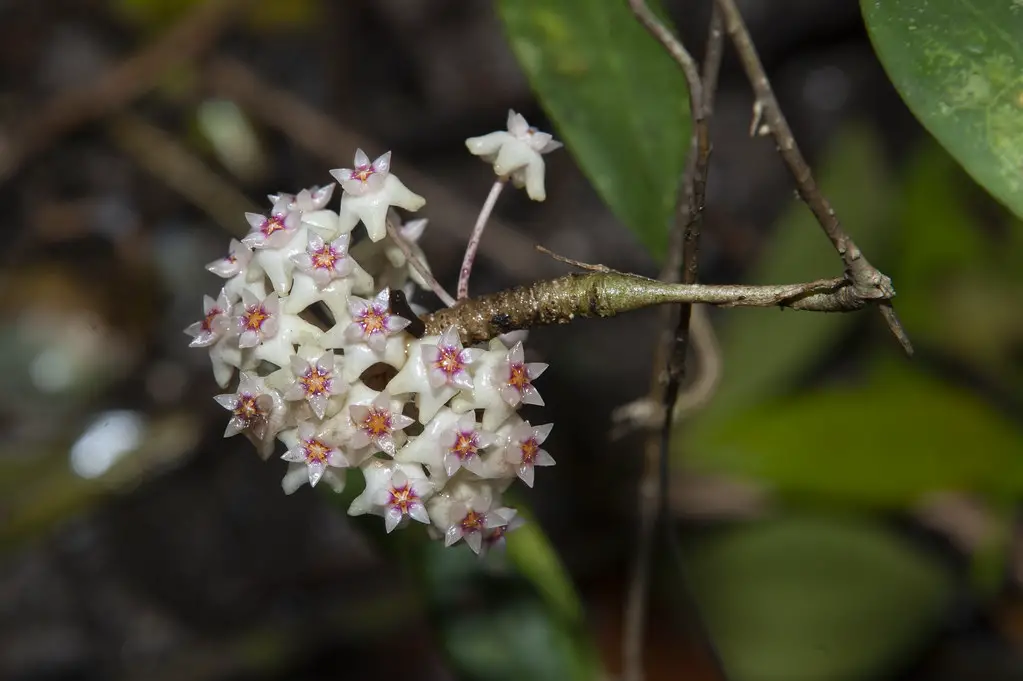Hoyas, also known as wax plants, are a diverse and captivating genus of climbing or trailing tropical plants. With over 200 species, Hoyas are cherished for their gorgeous, waxy leaves and aromatic, star-shaped flowers. These resilient plants add an exotic touch to indoor spaces and are often admired for their ability to thrive in various environments.
Native to Southeast Asia and Australia, Hoyas have spread across the globe as favored houseplants. Their unique appearance, ranging from velvety leaves to succulent varieties, adds intrigue and variation to any collection. The stunning clusters of flowers, often referred to as “porcelain flowers” or “wax flowers,” can last for several weeks, giving off a pleasant fragrance and adding to their allure.
In addition to their beauty, Hoyas are known for being relatively low-maintenance, requiring basic care, and offering flexibility in various growing conditions. Their popularity among plant enthusiasts continues to grow, and their broad range of species ensures that there is a Hoya to fit every preference and space.
| Attribute | Details |
|---|---|
| Common Names | Wax Plant, Porcelain Flower |
| Botanical Name | Hoya |
| Family | Apocynaceae |
| Plant Type | Evergreen Perennial |
| Mature Size | Varies (generally 2-4 feet in height) |
| Sun Exposure | Bright, indirect light |
| Soil Type | Well-draining soil |
| Hardiness Zones | 10-12 |
| Native Area | Southeast Asia, Australia |
Hoya Care
The care of Hoya plants is often considered straightforward, making them an excellent choice for both novice and experienced plant enthusiasts. These adaptable plants generally thrive in bright, indirect light, although some species can tolerate lower light conditions. Providing well-draining soil, proper watering, and maintaining a stable environment will lead to healthy and flourishing Hoya plants.
The beauty of Hoya plants lies in their resilience and adaptability. While they prefer certain conditions, they are forgiving and can adapt to various environments. Understanding the specific needs of the chosen Hoya species and adjusting care accordingly will ensure success in growing these stunning plants.
Light Requirement for Hoya
Hoyas thrive in bright, indirect sunlight. Too much direct sun can scorch the leaves, while too little light may hinder flowering. East or west-facing windows are usually ideal for most Hoyas. Light requirements might vary slightly between different Hoya species, so it’s wise to research the specific needs of your particular plant.
Soil Requirements for Hoya
A well-draining soil mix that includes peat moss and perlite is typically suitable for Hoya plants. Good drainage is essential to prevent root rot, as these plants are sensitive to over-watering. The soil should be kept slightly moist but never soggy.
Water Requirements for Hoya
Watering Hoyas should be done with care, allowing the top inch of soil to dry out between waterings. Over-watering can lead to root rot, while under-watering may cause the leaves to shrivel. Finding a balanced watering routine is key to maintaining healthy Hoyas.
Temperature and Humidity
Hoyas prefer a temperature range of 60-80°F (15-27°C) and humidity levels of 40-60%. While they can adapt to lower humidity, using a humidifier or misting the plants can promote better growth, especially in drier climates.
Fertilizer
A balanced, water-soluble fertilizer applied every 4-6 weeks during the growing season will support robust growth and flowering. It is essential to follow the fertilizer instructions and avoid over-fertilizing, as this can harm the plant.
Pruning Hoya
Pruning can be done to shape the plant or remove dead or diseased growth. Care should be taken not to over-prune, as this might hinder flowering. Some growers prefer to let their Hoyas grow naturally, embracing their wild and trailing nature.
Propagating Hoya
Propagation of Hoya is commonly done through stem cuttings. A healthy stem with at least one node can be placed in water or soil to root. Propagation allows for easy sharing of these beautiful plants with friends and family.
How To Grow Hoya From Seed
Growing Hoya from seed is more complex and time-consuming than other propagation methods. Seeds must be fresh and sown in a well-draining mix, keeping the environment humid and warm. Patience is required, as germination may take several weeks or even months.
Common Pests & Plant Diseases
Aphids
These can be treated with insecticidal soap or neem oil.
Mealybugs
Remove manually or treat with appropriate insecticides.
Scale
Treat by wiping with alcohol or using horticultural oil.
Root Rot
Caused by over-watering, root rot can be prevented by proper watering practices and well-draining soil.
Common Problems With Hoya
Yellowing Leaves
This could be a sign of over-watering. Adjust watering practices and ensure proper drainage.
Lack of Flowering
Insufficient light or incorrect pruning may prevent flowering. Assess and adjust light conditions and be mindful of pruning near flower sites.
Wrinkled Leaves
Often a sign of under-watering or low humidity. Regular watering and increasing humidity can resolve this issue.
Pro Tips
- Provide consistent bright, indirect light.
- Use a well-draining soil mix.
- Avoid over-watering; let the top inch of soil dry between waterings.
- Regularly inspect for pests and diseases.
- Be patient with flowering; it may take time for a new Hoya to bloom.
- Embrace the natural growth pattern or prune to your preference.




